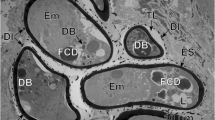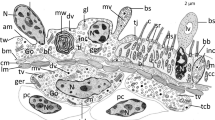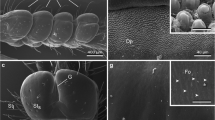Summary
The ventral epidermis of adult Necturus maculosus has been studied using electron and light microscopy. Many larval characteristics of amphibian epidermal structure are retained in adult Necturus. The epidermis is a stratified epithelium consisting of four cell layers and five cell types. Major differences compared with other adult amphibians are: (1) the absence of a well defined moulting cycle together with an apparently diminished synthetic and mitotic activity in the stratum germinativum; (2) an outermost cell layer (stratum mucosum) that is unkeratinized and appears to synthesize a mucous layer; and (3) numerous large club-shaped Leydig cells which span the epidermis between the cells of the stratum germinativum and stratum mucosum. The apical region of the stratum granulosum and stratum mucosum cells shows evidence of extensive synthesis. The stratum mucosum appears to be involved in the secretion of vesicular contents onto the outermost surface of the epithelium. The external surfaces of the stratum mucosum cells possess numerous microridges which are supported by an intricate network of cytofilaments in the apical region of these cells. The significance of these features is discussed in relation to the physiology and ecology of this species.
Similar content being viewed by others
References
Andrew W, Hickman CP (1974) Histology of the vertebrates. CV Mosby Co, St Louis, pp 44–49
Baldwin GF, Bentley PJ (1982) Roles of the skin and gills on sodium and water exchanges in neotenic urodele amphibians. Am J Physiol 242:R94-R96
Bentley PJ, Shield JW (1973) Respiration of some urodele and anuran amphibia — II: In air, role of the skin and lungs. Comp Biochem Physiol 46A:29–38
Bentley PJ, Yorio T (1977) The permeability of the skin of a neotenous urodele amphibian, the mudpuppy Necturus maculosus. J Physiol (London) 265:537–547
Bishop SC (1926) Notes on the habits and developments of the mud puppy Necturus maculosus (Raf.). NY State Mus Bull 268:1–60
Bullivant S (1981) Possible relationships between tight junction structure and function. In: Macknight ADC, Leader JP (eds) Epithelial ion and water transport. Raven Press, New York
Conant R (1975) A field guide to reptiles and amphibians of Eastern and Central North American, 2nd ed. Houghton Mifflin Co, Boston, pp 241–243
Dawson AB (1920) The integument of Necturus maculosus. J Morphol 34:487–589
Elkan E (1968) Mucopolysaccharides in the anuran defence against desication. J Zool 155:19–53
Erlij D, Martinez-Palomo A (1978) Role of tight junctions in epithelial function. In: Giesbisch G, Tosteson DC, Ussing HH (eds) Membrane transport in biology. Vol III:27–53. Transport across multimembrane systems. Springer, New York
Eycleshymer AC, Wilson JM (1910) Normal plates of the development of Necturus maculosus. Normentafeln zur Entwicklungsgeschichte der Wirbeltiere. Keibel F, Jena, Heft 11. (Cited by Dawson, 1920)
Farquhar MG, Palade GE (1964) Functional organization of amphibian skin. Proc Natl Acad Sci USA 51:569–577
Farquhar MG, Palade GE (1965) Cell junctions in amphibian skin. J Cell Biol 26:263–291
Flaxman BA (1972) Cell differentiation and its control in the vertebrate epidermis. Am Zool 12:13–25
Gersch H (1942) Aufbau und Differenzierung des Integumentes vom Axolotl auf Grund einer vergleichenden Untersuchung mit Hilfe vitaler und histologischer Färbemethoden. Z Mikrosk Anat Forsch 51:513–544. (Cited by Rosenberg et al. 1982)
Guimond RW, Hutchison VH (1972) Pulmonary, branchial and cutaneous gas exchange in the mudpuppy, Necturus maculosus maculosus (Rafinesque). Comp Biochem Physiol 42A:367–392
Harris JP (1959) The natural history of Necturus: I. Habits and habitats. Field Lab 27:11–20
Hay E (1961) Fine structure of an unusual intracellular supporting network in the Leydig cells of Amblystoma. J Biophys Biochem Cytol 10:457–463
Hughes GM (1982) Functional morphology offish gills. In: Lahlou B (ed) Epithelial transport in the lower vertebrates. Cambridge University Press
Kanwar YS, Hascall VC, Farquhar MG (1981) Partial characterization of newly synthesized proteoglycans isolated from the glomerular basement membrane. J Cell Biol 90:527–532
Kelly DE (1966a) Fine structure of desmosomes, hemidesmosomes, and an adepidermal globular layer in developing newt epidermis. J Cell Biol 28:51–72
Kelly DE (1966b) The Leydig cell in larval amphibian epidermis. Fine structure and function. Anat Rec 154:685–700
Laschi R, Govoni E (1978) Staining methods for semithin sections. In: Johannessen JV (ed) Electron microscopy in human medicine, Vol 1. McGraw-Hill, New York, pp 187–198
Lavker RM (1972) Fine structure of the newt epidermis. Tissue Cell 4:663–675
Mittal AK, Munshi JSD (1971) A comparative study of the structure of the skin of certain air-breathing fresh-water teleosts. J Zool 163:515–532
Mowry RW (1963) The special value of methods that color both acidic and vicinal hydroxyl groups in the histochemical study of mucins. In: Jawoski S (ed) Mucous secretions. Ann NY Acad Sci 106:402–423
Noble KG (1931) The biology of the amphibia. Dover Publications Inc, New York, 1954
Parakkal PF, Matoltsy AG (1964) A study of the fine structure of the epidermis of Rana pipiens. J Cell Biol 20:85–94
Pearse AGE (1972) Histochemistry. Theoretical and applied. Churchill Livingston, Edinburgh
Reynolds ES (1963) The use of lead citrate at high pH as an electron-opaque stain in electron microscopy. J Cell Biol 17:208–213
Rosenberg M, Lewinson D, Warburg MR (1982) Ultrastructural studies of the epidermal Leydig cell in larvae of Salamandra salamandra (Caudata, Salamandrida). J Morphol 174:275–281
Shield JW, Bentley PJ (1973) Respiration of some urodele and anuran amphibia — I. In water, role of the skin and gills. Comp Biochem Physiol 46A:17–28
Spearman RIC (1968) Epidermal keratinization in the salamander and a comparison with other amphibia. J Morphol 125:129–144
Spurr AR (1969) A low-viscosity epoxy resin embedding medium for electron microscopy. J Ultrastruct Res 26:31–43
Takagi T, Saito H (1979) Surface architecture of the epidermal cells in newt larvae. J Electron Microsc 28:159–164
Wagner RC (1976) The effect of tannic acid on electron images of capillary endothelial cell membranes. J Ultrastruct Res 57:132–139
Warburg MR, Lewinson D (1977) Ultrastructure of epidermis of Salamandra salamandra followed throughout ontogenesis. Cell Tissue Res 181:369–393
Weiss P, Ferris W (1954) Electron micrographs of larval amphibian epidermis. Exp Cell Res 6:546–549
Whitear M (1975) Flask cells and epidermal dynamics in frog skin. J Zool 175:107–149
Author information
Authors and Affiliations
Rights and permissions
About this article
Cite this article
Lindinger, M.I. Fine structure of the abdominal epidermis of the adult mudpuppy, Necturus maculosus (Rafinesque). Cell Tissue Res. 238, 395–405 (1984). https://doi.org/10.1007/BF00217313
Accepted:
Issue Date:
DOI: https://doi.org/10.1007/BF00217313




